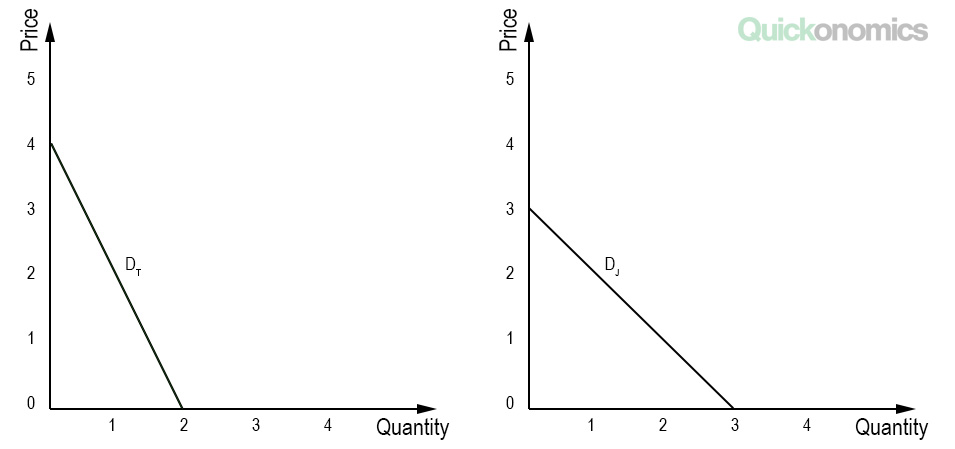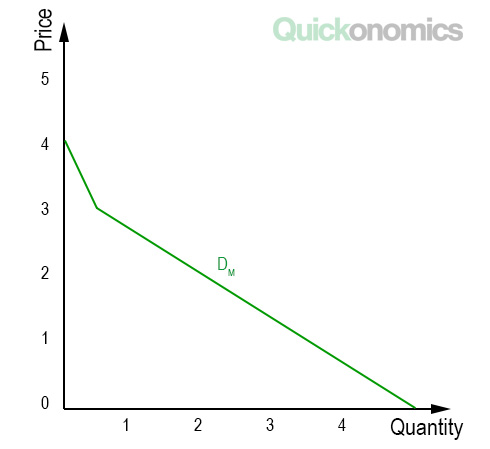Updated Jun 26, 2020 t In an economic context, demand is defined as the quantity of a specific good or service that consumers are willing and able to buy over a given period. As you can tell, this definition looks at all consumers combined (i.e., aggregated data). However, individual consumers may have different preferences and individual budget constraints. Therefore, when we analyze demand, it is essential to distinguish between two different types: individual demand and market demand. We will look at them in more detail below. Individual demand describes the ability and willingness of a single individual to buy a specific good or service. As indicated above, this largely depends on the price of the product as well as individual preferences. In most cases (i.e., for normal goods), demand increases when the price of a good or service decreases. This relationship between price and quantity can be illustrated using a demand curve (see also the law of supply and demand). To give an example, let’s look at the two diagrams below. They illustrate the demand curves for ice cream of two individuals – Tom and Jerry. Tom’s demand curve (DT) shows us how much ice cream he is willing and able to buy at different prices, whereas Jerry’s curve (DJ) represents his willingness and ability to buy ice cream. Notice that the two curves have different slopes. While Tom is willing to buy ice cream up to a price of USD 4.00, Jerry will only pay a maximum of USD 3.00. However, if the ice cream were free (i.e., price = USD 0.00), Jerry would eat 3 cones, while Tom would only eat 2. That is a beautiful example of the difference between willingness and ability to buy. More specifically, even though Tom’s demand curve clearly shows that he’ll pay more for an ice cream cone, that does not necessarily mean he likes ice cream more than Jerry. Maybe he has more money to spend, so he doesn’t care how much his ice cream costs. However, to analyze this further, we’d have to consider their individual indifference curves and budget constraints as well. Market demand describes the quantity of a particular good or service that all consumers in a market are willing and able to buy. In other words, it represents the sum of all individual demands for a particular good or service. Again, this is a lot easier to understand if we look at the corresponding demand curve. If we revisit our example from above, we have two individual demand curves. The first one represents Tom’s individual demand, while the second one describes Jerry’s demand. Hence, to calculate market demand for ice cream in this example, all we have to do is horizontally sum the two individual demand curves. This results in the following market demand curve (DM): Note that the curve has a sharp bend at a price of USD 3.00. The reason for this is that Jerry won’t buy any more ice cream above this price, so the market demand curve above USD 3.00 is, in fact, equal to Tom’s individual demand curve. For all prices below USD 3.00 market demand is equal to Tom’s individual demand plus Jerry’s individual demand (see above). For example, at a price of USD 2.00, market demand is 2 ice cream cones (1 for Tom and 1 for Jerry). Meanwhile, at a price of USD 0.00, market demand adds up to 5 cones (2 for Tom and 3 for Jerry). Demand is defined as the quantity of a specific good or service that consumers are willing and able to buy over a given period. However, it is important to distinguish between two different types of demand: individual demand and market demand. Individual demand describes the ability and willingness of a single individual to buy a specific good or service. Meanwhile, market demand is defined as the quantity of a particular good or service that all consumers in a market are willing and able to buy (i.e., the sum of all individual demands for a particular good or service).Individual Demand

Market Demand

Summary
Microeconomics